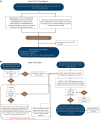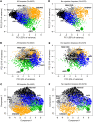A cross-sectional study of the role of epithelial cell injury in kidney transplant outcomes
- PMID: 40232852
- PMCID: PMC12128995
- DOI: 10.1172/jci.insight.188658
A cross-sectional study of the role of epithelial cell injury in kidney transplant outcomes
Abstract
Background: Expression of acute kidney injury-associated (AKI-associated) transcripts in kidney transplants may reflect recent injury and accumulation of epithelial cells in "failed repair" states. We hypothesized that the phenomenon of failed repair could be associated with deterioration and failure in kidney transplants.
Methods: We defined injury-induced transcriptome states in 4,502 kidney transplant biopsies injury-induced gene sets and classifiers previously developed in transplants.
Results: In principal component analysis (PCA), PC1 correlated with both acute and chronic kidney injury and related inflammation and PC2 with time posttransplant. Positive PC3 was a dimension that correlated with epithelial remodeling pathways and anticorrelated with inflammation. Both PC1 and PC3 correlated with reduced survival, with PC1 effects strongly increasing over time whereas PC3 effects were independent of time. In this model, we studied the expression of 12 "new" gene sets annotated in single-nucleus RNA-sequencing studies of epithelial cells with failed repair in native kidneys. The new gene sets reflecting epithelial-mesenchymal transition correlated with injury PC1 and PC3, lower estimated glomerular filtration rate, higher donor age, and future failure as strongly as any gene sets previously derived in transplants and were independent of nephron segment of origin and graft rejection.
Conclusion: These results suggest 2 dimensions in the kidney transplant response to injury: PC1, AKI-induced changes, failed repair, and inflammation; and PC3, a response involving epithelial remodeling without inflammation. Increasing kidney age amplifies PC1 and PC3.
Trial registration: INTERCOMEX (ClinicalTrials.gov NCT01299168); Trifecta-Kidney (ClinicalTrials.gov NCT04239703).
Funding: Genome Canada; Natera, Inc.; and Thermo Fisher Scientific.
Keywords: Molecular diagnosis; Nephrology; Organ transplantation; Transplantation.
Figures








References
Publication types
MeSH terms
Associated data
LinkOut - more resources
Full Text Sources
Medical
Research Materials
Miscellaneous

